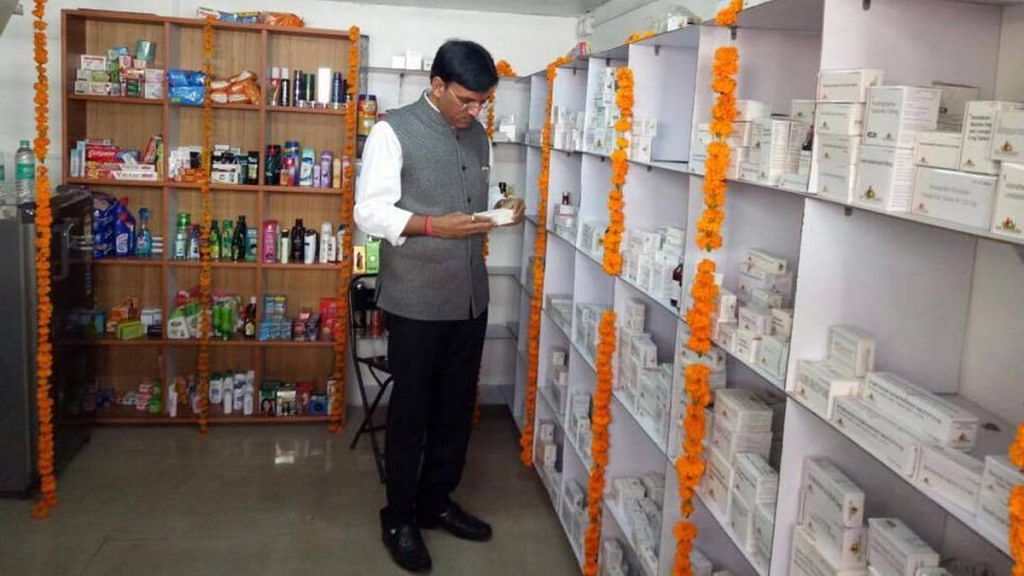New Delhi: The turnaround of the Modi government’s affordable generic drugs scheme — which saw an increase in revenue by over 55 times in five years, to Rs 665 crore in 2020-21 fiscal from Rs 12 crore in 2016-17 — is believed to have played a key role in the promotion of Mansukh Mandaviya as the Union health minister.
Though the scheme was started by the UPA government as the Jan Aushadhi Yojana, Mandaviya is credited with having turned an “ailing” project into a highly productive one.
He now also holds the portfolio for chemicals and fertilisers, for which he was earlier appointed the minister of state (MoS) in 2016. Through the ministry’s Department of Pharmaceuticals, Mandaviya had been promoting the scheme, renamed the Pradhan Mantri Bharatiya Janaushadhi Pariyojana (PMBJP), aggressively in the past five years.
Since coming to power, Prime Minister Narendra Modi often emphasised on his government’s commitment to boost the PMBJP. He promoted the scheme in several of his election rallies and even during his monthly ‘Mann Ki Baat’ addresses, including in its first episode in 2018.
Though sales and the number of stores operating under the scheme started showing an immediate improvement from the 2016-17 fiscal, the project was troubled with allegations of corruption and misappropriation of funds, made by the Centre’s internal audit committee in 2018 and 2019. To combat this, Mandaviya appointed a new CEO, Sachin Singh, in 2018.
“When Mandaviya took charge (of the ministry) in 2016-17, sales under the scheme were just Rs 12 crore in 2015-16. Last fiscal, the scheme posted revenue of Rs 665 crore — a growth of over 5,500 per cent,” a senior government official told ThePrint on the condition of anonymity.
According to data accessed by ThePrint, in 2015-16, around 240 outlets were operating under the Jan Aushadhi Yojana. The number has since gone up by over 33 times (3,233 per cent) to around 8,000 outlets across India today.
“In the first quarter of the ongoing fiscal year, we have already recorded a turnover of more than Rs 200 crore. While the official revenue target is to achieve Rs 625 crore this fiscal, we anticipate to earn around Rs 1,000 crore. This speaks volumes about his (Mandaviya’s) administration and leadership skills,” the official said.
Another official, who works closely with Mandaviya on drug policy related matters, said, “This scheme — which is known to be very dear to PM Modi — had been labelled as a failed, corruption-marred programme. But now, it is one of the most successfully running schemes under the Modi government.”
“Sales (under the scheme) have been very good and sometimes better than the sales in the regular pharma retail market. This must have boosted the CV of the minister. He has been very humble in accepting the flaws of the scheme and bringing in the right people to manage them,” the official added.
Also read: Modi cabinet reshuffle done, 43 new ministers take oath — Here is the full list of portfolios
Five-year expansion
Launched by the UPA in November 2008, the scheme aimed to ensure “availability of quality medicines at affordable prices to all”, by selling cheaper generic medicines at more than 3,000 outlets across the country.
The government had opened 199 stores for the scheme. However, a report by a Parliamentary standing committee in 2014-15 stated that only 99 of these were operational. The report claimed that the UPA was going “too slow” on expansion.
In September 2015, more than a year after Modi came to power, the scheme was rebranded and relaunched as the PMBJP.
Data accessed by ThePrint shows that the scheme started growing with each fiscal after Mandaviya took charge in 2016.
In 2015-16, the scheme posted sales of Rs 12 crore, which increased to Rs 33 crore in 2016-17, Rs 140 crore in 2017-18, Rs 315 crore in the following fiscal, Rs 433 crore in the one after and finally Rs 665.83 crore in 2020-2021.
Similarly, stores operating under the scheme grew from 240 in 2015-16 to 960 the next fiscal, going up to 3,193, then 5,056 in 2018-19, 6,306 in the next year, and finally 7,557 in 2020-2021.
As of the first quarter of this fiscal (2021-22), there are 7,894 outlets operating under the scheme across India, and revenue earnings have been Rs 210 crore.
Also read: 2 ministers below 40 years, number of under-60s doubles — age plays big role in reshuffle
From reporting a scam to fixing lapses
On some fronts, however, the scheme continued to struggle till 2018, with frequent product recalls and stock shortages.
In 2018, the government’s internal audit committee, the Office of Chief Controller of Accounts, had slapped charges of misappropriation of funds on the scheme.
The audit report had made 14 points against the Bureau of Pharma PSUs of India (BPPI), the department running the Jan Aushadhi stores, for irregularities noticed between 2014-15 and 2016-17. These included mismanagement of funds, medicines being sold at prices higher than the market rates and acceptance of medicines that should have been rejected according to its guidelines.
In 2019, a second audit for the 2014-15 to 2017-18 fiscals had found that the BPPI had allegedly backdated entries in its account books, delayed payment of taxes to the government and evaded paying gratuity to employees, among other irregularities.
The ministry had claimed to have corrected the lapses with Singh, an Indian Revenue Service (IRS) official, at the helm as the new CEO. Under him, the scheme had claimed to have filled gaps highlighted by the audit, made softwares to handle supply and demand, reduced chances of errors in payment collection, devised techniques for quality checks and opened a new warehouse equipped with latest technology.
“Now, everything is fool-proof,” Singh had told ThePrint after the second audit.
(Edited by Poulomi Banerjee)
Also read: PM Modi’s new team is a governance reboot tempered with politics
